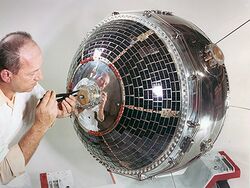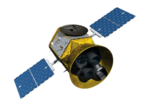Astronomy:Explorer 32
 | |
| Names |
|
|---|---|
| Mission type | Aeronomy |
| Operator | NASA |
| COSPAR ID | 1966-044A |
| SATCAT no. | 02183 |
| Website | NSSDC Master Catalog - Explorer 32 |
| Mission duration | 10 months |
| Spacecraft properties | |
| Payload mass | 224.5 kilograms (495 lb) |
| Start of mission | |
| Launch date | 13:55:00, May 25, 1966 (UTC) |
| Rocket | Delta-C1 |
| Launch site | Cape Canaveral Air Force Station LC-17B |
| End of mission | |
| Disposal | Deorbited (battery failure) |
| Decay date | February 22, 1985 |
| Orbital parameters | |
| Reference system | Geocentric |
| Regime | Low Earth |
| Eccentricity | 0.15532 |
| Apogee altitude | 2,725 kilometres (1,693 mi) |
| Inclination | 64.67° |
| Period | 116 minutes |
| Argument of perigee | 276 kilometres (171 mi) |
| Payload | |
| Ion Mass Spectrometer Neutral Particle Magnetic Mass Spectrometer Satellite Drag Atmospheric Density Pressure Gauges Electron Temperature and Density | |
| Instruments | |
| Mass Spectrometer | |
Explorers | |
Explorer 32, also known as Atmosphere Explorer-B (AE-B), was a satellite launched by the United States to study the Earth's upper atmosphere. It was launched from Cape Canaveral Air Force Station on a Delta-C1 rocket, on May 25, 1966. It was the second of five Atmosphere Explorers, the first being Explorer 17.
Technical specifications
Explorer 32 was a stainless steel, vacuum-sealed sphere, 0.889 metres (2.92 ft) in diameter.[1] It carried one ion[further explanation needed] and two neutral mass spectrometers, three magnetron density gauges, and two electrostatic probes. It used a tape recorder to save data that was acquired when the satellite was not in range of one of the 13 ground stations. It was powered by silver-zinc batteries and a solar cell array.
The satellite had an operational life of 10 months. The two neutral mass spectrometers failed a few days after launch, but the remaining instruments operated throughout most of the satellite's lifetime. Explorer 32 suffered a depressurization which led to battery failure, at which point it ceased functioning.[1]
Scientific experiments
Explorer 32 was designed to directly measure the temperature, composition, density, and pressure of the upper atmosphere.[2]
The ion mass spectrometers measured the concentrations of different types of ions in the topside ionosphere, principally atomic hydrogen, helium, nitrogen, and oxygen. The concentrations were recorded as a function of time, location, and solar and geomagnetic activity. The satellite was able to perform a global study of the diurnal variation of the atmosphere during nearly two complete diurnal cycles, since the orbit plane precessed one revolution each 5.5 months. The data from the ion mass spectrometers allowed for studies of: (1) the diurnal and seasonal variation of atmospheric ion composition, (2) the effect of atmospheric winds on the atomic hydrogen-atomic oxygen ion transition level, (3) the density and temporal variation of thermospheric atomic hydrogen, and (4) the altitude variation of ion composition in the midlatitude trough region.[3]
The three magnetron density gauges measured the density of the neutral atmosphere as a function of altitude, time, latitude, and solar and geomagnetic activity.[4]
The electron temperature and density instrument measure the distribution of electron temperatures and densities using a swept voltage electron probe.[4]
The two neutral particle magnetic mass spectrometers were intended to measure the composition of the neutral atmosphere at altitudes between 285 and 1,000 kilometres (935,000 and 3,281,000 ft). One spectrometer failed after 4 days, and the other failed after 7 days in orbit.
The satellite drag atmospheric density experiment measured the density of the upper atmosphere as a function of altitude, latitude, season, and solar activity. The experiment was possible due to the symmetrical shape of Explorer 32. When the satellite was near perigee, it was observed by networks of ground-based Baker-Nunn cameras, as well as being tracked by radio and radar. Sequences of these observations were used to deduce the density of the atmosphere that the satellite was passing through.[5]
See also
- 1966 in spaceflight
References
- ↑ 1.0 1.1 "NSSDC/COSPAR ID: 1966-044A". National Aeronautics and Space Administration. https://nssdc.gsfc.nasa.gov/nmc/spacecraft/display.action?id=1966-044A. Retrieved 22 March 2015.
- ↑ "Atmosphere and Earth Sciences". http://www.planet4589.org/space/misc/explorer.html. Retrieved 22 March 2015.
- ↑ "Ion Mass Spectrometer: NSSDC ID: 1966-044A-01". NASA. https://nssdc.gsfc.nasa.gov/nmc/experiment/display.action?id=1966-044A-01. Retrieved 13 June 2018.
 This article incorporates text from this source, which is in the public domain.
This article incorporates text from this source, which is in the public domain.
- ↑ 4.0 4.1 Dyson, P. L.; Newton, G. P.; Brace, L. H. (1970). "In situ measurements of neutral and electron density wave structure from the Explorer 32 satellite". Journal of Geophysical Research 75 (16): 3200–3210. doi:10.1029/JA075i016p03200. Bibcode: 1970JGR....75.3200D.
- ↑ Newton, George P. (1969). "Resolution of the difference between atmospheric density measurements from Explorer 17 satellite by density gage and drag techniques". Journal of Geophysical Research 74 (26): 6409–6414. doi:10.1029/JA074i026p06409. Bibcode: 1969JGR....74.6409N.
External links


